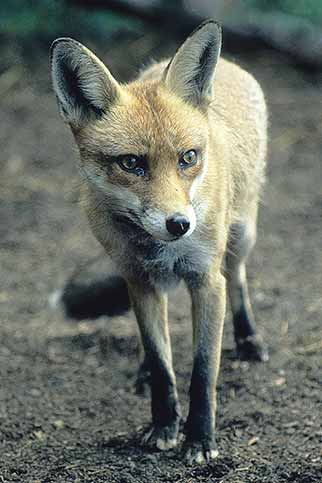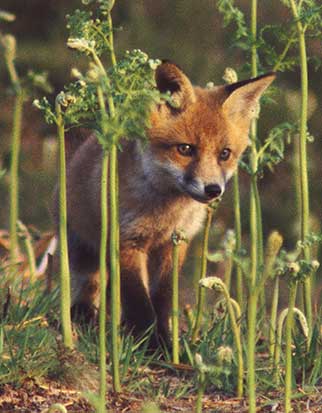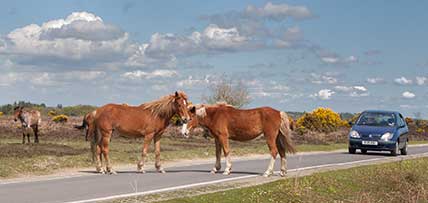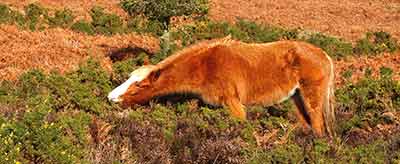New Forest foxes - introduction and general description

Introduction and description
Sleek, fine-boned, strong, energetic and highly intelligent; red foxes really are incredible creatures. And in the countryside, hunting with dogs and, latterly, other forms of persecution have ensured that foxes have remained wild and relatively unapproachable.
Foxes - themselves members of the dog family - are relatively small creatures, not much bigger than a small Collie dog, and with strong but very slender legs. In fact, it’s something of a puzzle that foxes ever had the speed and stamina to evade the hunt, although they can apparently reach speeds of 30 miles per hour.
Coat colour varies. Typically a rich, reddish-brown, some foxes, though, are sandy-coloured, whilst others are considerably darker than normal. A white neck and belly are typical and so is white around the nose and upper lip. The tail is long, thick and bushy with, in some individuals, a conspicuous white tip. Dark 'socks' on the lower legs are usually present, and the backs of the pointed, erect ears are also usually dark in colour.
Dogs and vixens are hard to tell apart, but if a good view is available during the winter breeding season, dog foxes' testes may be noticed, whilst in spring, lactating vixens' teats may be seen.
Markings may, however, differ from animal to animal, which is a useful feature for anybody who wants to identify individuals amongst the local fox population. Look out for variable extents of white on the chin, throat and chest; an optional, sometimes conspicuously white, sometimes dark, tip to the tail; and differently coloured lower legs – some dark, some not.
Territorial behaviour and social lives
Territories are jealously guarded, and physical battles do occur, particular during the mating season and when young of the year are dispersing and attempting to claim their own territories. Scent marking, strategically placed droppings and night-time calls are, however, often enough to deter interlopers.
Although usually seen singly, at least some foxes lead relatively complex social lives. Some dog foxes and vixens form a pair that may last for life, although outside the breeding season contact may be infrequent, and dog foxes, in particular, may wander in search of other matings. Then in well-studied urban areas with high fox populations, the animals have been found to live in social groups within which only a dominant pair usually breed, but others help to catch food on which to feed the cubs.
How far do New Forest foxes travel?
That is a good question. A study carried out by the Fordingbridge-based Game and Wildlife Conservation Trust involved monitoring fox movements via a special collar fitted to the animals and subsequent GPS tracking. Much to the surprise of researchers, one vixen tracked from April 2019 covered 15½ miles (25 kilometres) of the New Forest during a single night, and on another occasion strolled along the hard shoulder of the M27.
The vixen was initially believed to be part of a settled family occupying the river-side meadows where she was found, but GPS tracking showed that on one night she left the meadows and headed east, moved along the course of a stream and navigated forestry tracks, before settling near Totton, on the outskirts of Southampton.
And then one week later, she headed south-west, leaving Ower, near Totton, at around 10.00pm and travelling about 12½ miles (20 kilometres) back across the New Forest to the Avon Valley, following the A31 for part of the journey. By 5.00am she had arrived at the edge of a country estate a little to the south of Ringwood.

Mike Short, the Game and Wildlife Conservation Trust's predator ecologist, was quoted as saying: 'Our GPS-tracking of foxes in the Avon Valley has shown that while most foxes living around river meadows are highly territorial, some are surprisingly mobile. We don't know where this vixen came from, but she showed how easily a fox can travel 25 kilometres in one night. This could indicate that some of the foxes that threaten the Avon Valley's wading birds may migrate from Southampton or Bournemouth and Poole.'
Senses
Fox senses – hearing, eyesight and smell - are extremely well-developed as befits an animal that has long been hunted. Foxes, however, will not necessarily flee at the sight of humans, but do so only when they feel threatened, which often is when they realise that they have been noticed - I've on occasion seen a stationary fox in woodland calmly standing, waiting, watching me passing along a ride only for it to quickly move off when it has realised it's been observed.
Life span
Longevity is highly variable and is clearly influenced by the amount of persecution suffered at the hands of man. In captivity, foxes have a lifespan comparable to domestic dogs, that is, around 14 years, whereas in the wild, life expectancy is considerably less and in the countryside may not be much more than a couple of years.
Diet
Fox diet is made up of just about anything edible: mice, voles, rats, rabbits, hedgehogs, birds and their eggs and young, earthworms, fruit and berries, and probably much more.
In the New Forest, however, foxes also take grey squirrels, although catching squirrels on the ground must surely be a challenge to the foxes' patience, speed, agility and cunning. New Forest foxes also eat large numbers of dung beetles, and other types of beetles, making up for a relative shortage of rats, mice and voles - grazing pressure from deer and commoners’ stock greatly reduces the ground cover needed to support significant small mammal populations.
(Beetles have an odd, almost mutually beneficial relationship with the foxes, for dung beetles can sometimes be seen pulling fox droppings, containing beetle wing cases, down into their burrows to provision the next generation of newly hatched beetles. And equally oddly, it is not only beetles that make use of fox dung, for purple emperor butterflies - scarce nationally and very rarely sighted in the New Forest - are known to feed on these and many other, to us, horribly undesirable foodstuffs).
Active by night and also by day
Although typically active at dawn, dusk and through the night, in quieter places it’s not unusual to encounter a fox in daylight, particularly in winter, padding along a favourite woodland ride, stopping every few paces to listen, to stare down, to nose amongst the grass, to pounce on unfortunate prey items, and scent-mark prominent objects.
In fact, when there are cubs in the den, adult foxes will sometimes emerge in the middle of the day, stretch and then either return underground or wander off, presumably keen to take a break from the youngsters.

Vocalisations
Night-time vocalisations sometimes betray fox presence. The ‘vixen's scream’, a series of eerie shrieks, can be heard intermittently throughout the year, whilst breeding season territorial sounds are heard most often from December to February. The two most common fox sounds, a mid-tone ‘wow-wow-wow’ bark and a fearsome ‘waaaaaaaa’, sometimes given by a stationary animal but also given on the move, allow nocturnal passage through the countryside to be easily followed.
Evidence of presence
But evidence of a fox’s passing is more often encountered than the fox.
Fox scent lingering in the air may be detected, whilst fox paw prints may occasionally be noticed - they are quite small and typically narrower than those of domestic dogs.
Fox prey remains, too, can sometimes be seen, strewn about the woodland floor, along heathland paths and woodland rides, and around dens in spring occupied by cubs; whilst fox droppings (faeces) may often be seen, particularly along paths and tracks used by foxes.
Find out lots more about foxes
References:
Collins Field Guide to the Mammals of Britain and Europe: David Macdonald and Priscilla Barrett
Town fox, Country fox: Brian Vesey-Fitzgerald
Animals Tracks, Trails and Signs: RW Brown, MJ Lawrence, J Pope
Collins Guide to Animal Tracks and Signs: Preben Bang and Preben Dahlstrom
Fauna Britannica: Stefan Buczacki
Running with the Fox: David Macdonald
Fox: Martin Wallen
Wild Fox: Roger Burrows
The Diary of Colonel Peter Hawker
Thirty-five Years in the New Forest: Gerald Lascelles
BBC Wildlife on-line edition
Game and Wildlife Conservation Trust
Wildlife online - fox infanticide
More links
Other related links
Search this site
Sika deer continue to engage in rutting behaviour, and will do so until December.
Pigs seek out the remains of the acorn crop.
Beech leaves are transformed into a magnificent mosaic of glorious reds and golds. Other deciduous trees, too, take on an autumnal cloak before their leaves fall.
Dragonflies can occasionally be seen on the wing on bright days early in the month.
December
Foxglove leaves survive the winter at ground level, and offer the prospect of colourful summer blooms to come.
Redwings and fieldfares, autumn and winter visitors, gorge on haws and holly berries.
Great grey shrikes and hen harriers hunt over the heaths and other open spaces.
Honeysuckle by the end of the month often shows welcome signs of new growth.

Sadly, 58 animals were killed - 35 ponies, 13 cows, 8 donkeys and 2 sheep, whilst a further 32 were injured - 3 pigs, 9 donkeys, 11 cows and 9 ponies.
(Forty-three accidents occurred in daylight, 15 at twilight and 101 in the dark. Twenty-seven accidents were not reported by the driver involved).
Here's just one horrific example - Three donkeys killed in collision with van at notorious New Forest blackspot (Advertiser and Times)

